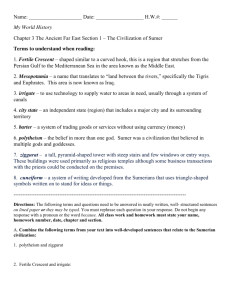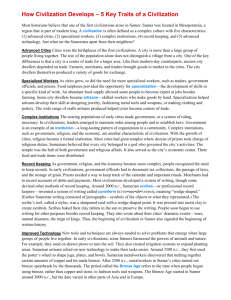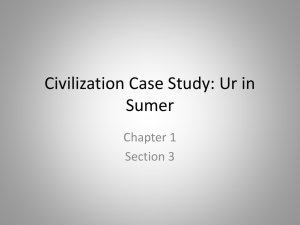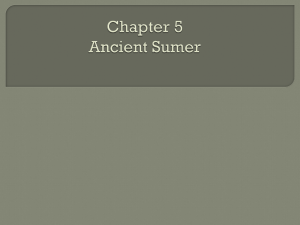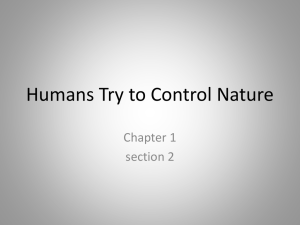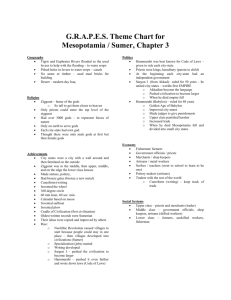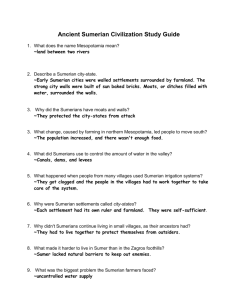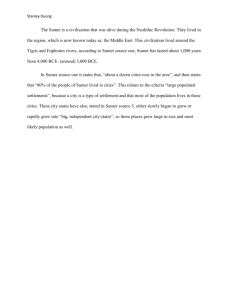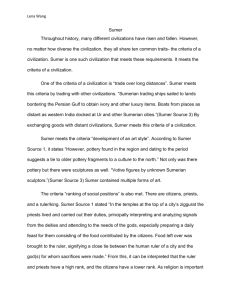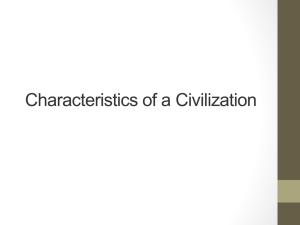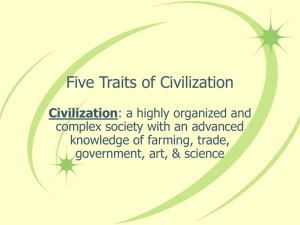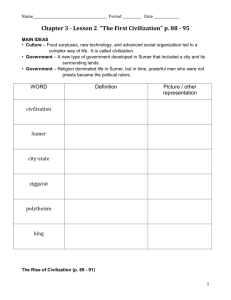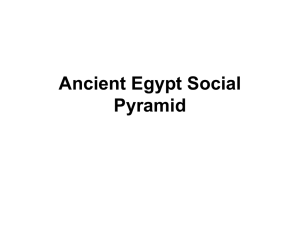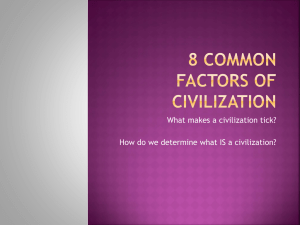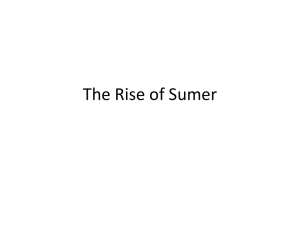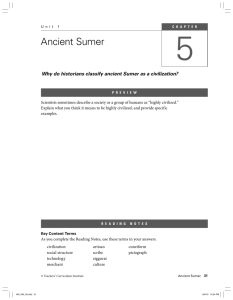Chapter 1.3
advertisement
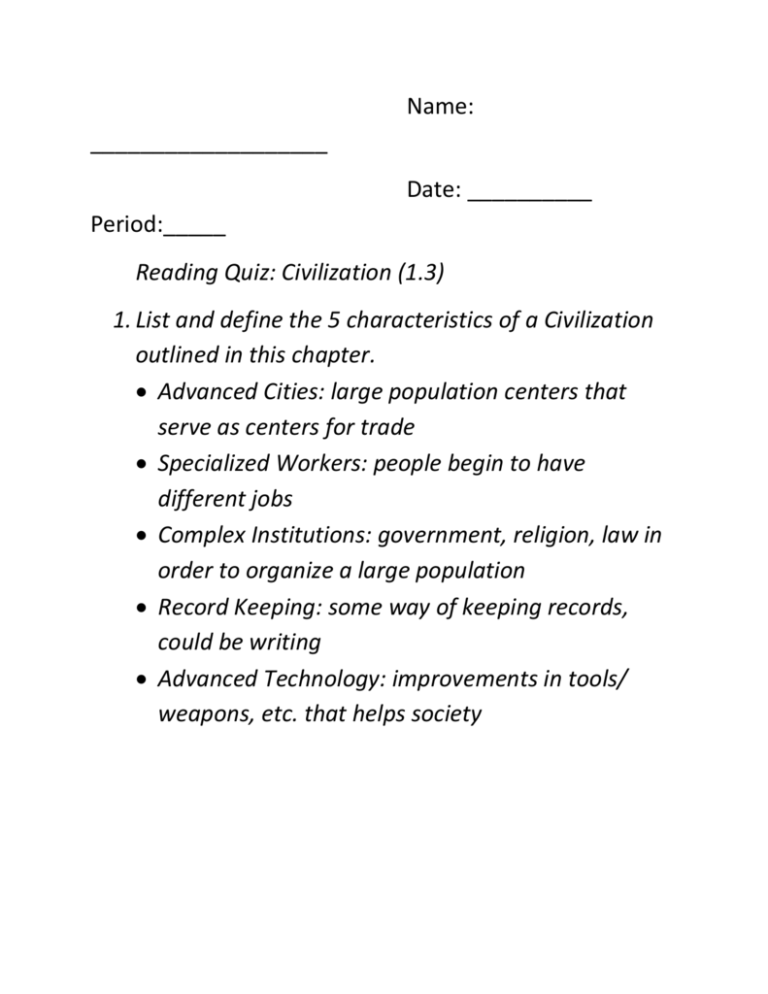
Name: ___________________ Date: __________ Period:_____ Reading Quiz: Civilization (1.3) 1. List and define the 5 characteristics of a Civilization outlined in this chapter. Advanced Cities: large population centers that serve as centers for trade Specialized Workers: people begin to have different jobs Complex Institutions: government, religion, law in order to organize a large population Record Keeping: some way of keeping records, could be writing Advanced Technology: improvements in tools/ weapons, etc. that helps society 2. List an example from Sumer for each of the 5 characteristics of a Civilization Advanced Cities Uruk (10,000) Lagash (19,000) Umma (16,000) Specialized Priests * metalworkers Workers * scribes *soldiers * teachers *weavers *merchants * government officials * potters * farmers Complex Formal governments with Institutions officials and laws Priests with both religious and political power A rigorous education system for training of scribes Record Keeping Cuneiform tablets- records of business transactions, historical events, customs, and traditions Advanced By Around 3000BCETechnology Wheel, plow, sailboat in daily use Bronze weapons and body armor that gave Sumerians a military advantage 3. What was the Bronze Age? (time period, location, key characteristics) Began in Sumer around 3000 BCE, and is a time when people started using Bronze (an alloy of copper and tin) to make stronger weapons and tools…led to increase in food production, as well as defense Chapter 1.3: Civilization- Case Study: Ur in Sumer I. Villages Grow into Cities Over the centuries, people settled in stable communities that were based on agriculture Domesticated animals became more common New tools: hoes, sickles, and plow sticks- farming easier (food surplus, population increase) More complex social relationships (specialization of labor, social hierarchies) A. Economic Changes Elaborate irrigation systems Improved techniques led to food surpluses, specialization of labor Craftspeople: pottery, metal objects, woven cloth o Broader range of goods to exchange- craftwork, grains, and many raw materials Two important inventions led to the expansion of trade between villages: Wheel and Sail B. Social Changes More complex and prosperous economy affected the social structure of village life Large-scale projects (like irrigation) needed skill and labor and organization of large groups of people Social classes with varying wealth, power, and influence began to emerge…social hierarchy Religion also became more organized o Religion centered around nature, animal spirits, and some idea of an afterlife o Neolithic Age- worship of many gods and goddesses, who they believed had power over the rain, wind, and other forces of nature II. What is Civilization? Most historians agree that the first civilizations arose in Sumer, (modern Iraq) Sumer was located in Mesopotamia Five Characteristics of Civilization: o 1. Advanced Cities o 2. Specialized Workers o 3. Complex Institutions o 4. Record Keeping o 5. Advanced Technology A. Advanced Cities Cities were the birthplaces of the first civilizations Key difference between a village and a city= city is a center of trade for a larger area o Dependent on trade B. Specialized Workers With increase in cities, increase in demand for specialized workers o Traders, government officials, priests Food surpluses allowed for specialization of labor Artisans: skilled workers who made goods by hand o Designing jewelry, fashioning metal tools and weapons, making pottery C. Complex Institutions With large populations, system of government was necessary Leaders emerged to maintain order and establish laws Institution- ex. Government long-lasting pattern of organization in a community Examples of Complex Institutions: government, religion, and the economy Religion became a formal institution Temples with priests and rituals Sumerians believed every city belonged to a god who lived in the temple and governed the city’s activities Temple= hub of government and religious affairs, and economic center D.Record Keeping With complex government, religion, and economy…need record keeping o Ex. Tax collections, passage of laws, and storage of grain, calendar, merchant debts and payments Most civilizations developed a system of writing (or other form of record keeping) 3000BCE: Sumerian scribes invented Cuneiform: wedge-shaped writing with a stylus on clay tablets Beginning of civilization in Sumer signaled the beginning of written history E. Advanced Technology Farmers began to use ox-drawn plows to turn the soil…elaborate irrigation systems to expand planting areas 3500BCE- Sumerian artisans began using potter’s wheel 2500BCE- Sumerian metalworkers were producing BRONZE spearheads and weapons Bronze Age= time with people began using bronze, rather than copper and stone, to fashion tools and weapons- began around 3000BCE in Sumer III. Civilization Emerges in Ur Ur- early Sumerian city on banks of Euphrates River in southern Iraq Population of 30,000 Archaeologist Leonard Woolley 1922-1934 Well defined social classes…priests and rulers had great power…wealthy merchants, artists and artisans A. An Agricultural Economy Mud-brick walls and buildings Use of ox-driven plows Large scale irrigation projects- food surplusesgovernment officials to plan and oversee public works B. A Glimpse of City Life One story mud-brick homes for poor, wealthy had 2story homes with inner courtyards Specialization of labor- artisans/metalworkers- tools, weapons, and trade items C. Ur’s Thriving Trade City Bazaar (marketplace) Have a system of Barter: trading goods and services without money D.The Temple: Center of City Life Temple is the most important building in the city, surrounded by a heavy wall Tiered structure called a ziggurat “mountain of god”…priests conduct rituals on top E. A Religious Ritual Recorded Sumerian Burial Rituals included making sacrifices of food Contemporaneous with the Sumerians were Egyptians, Chinese and other countries in Asia
